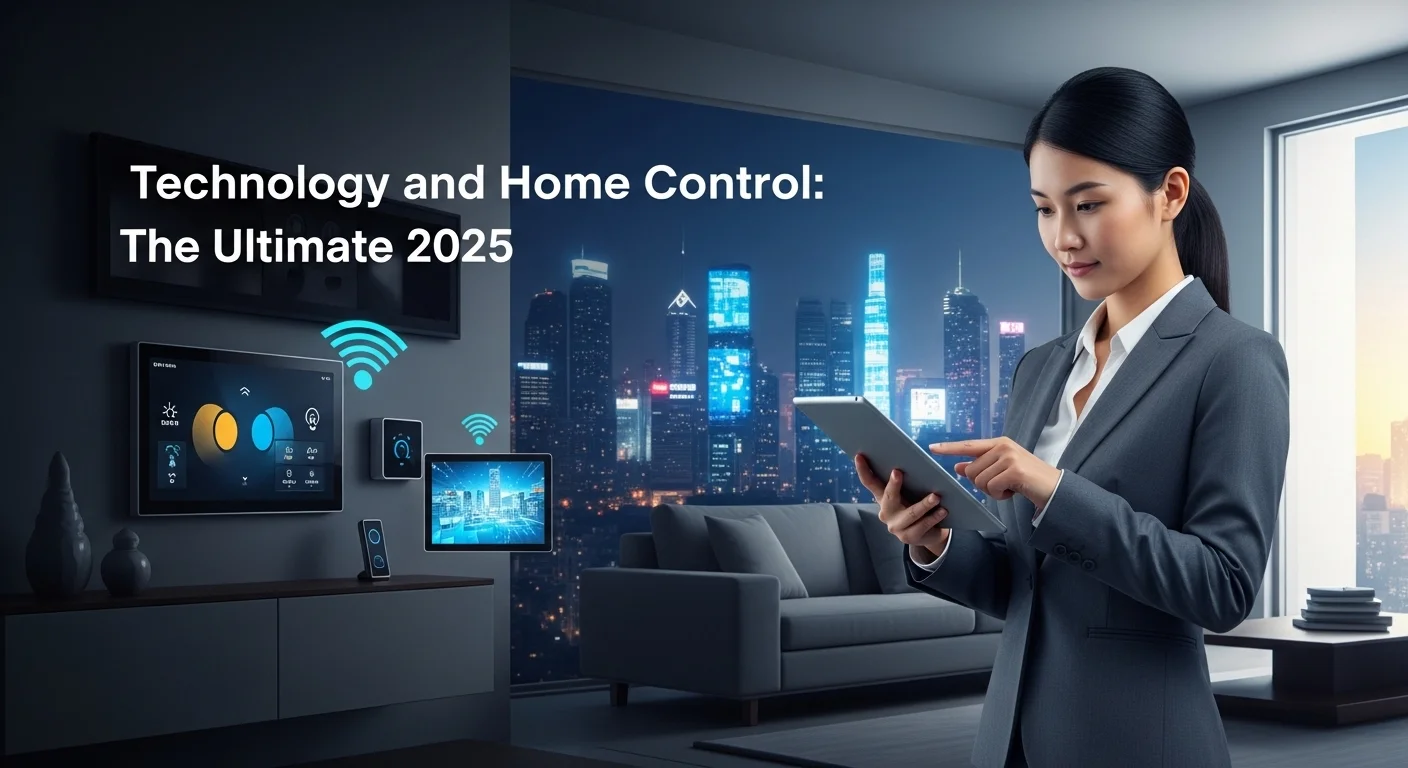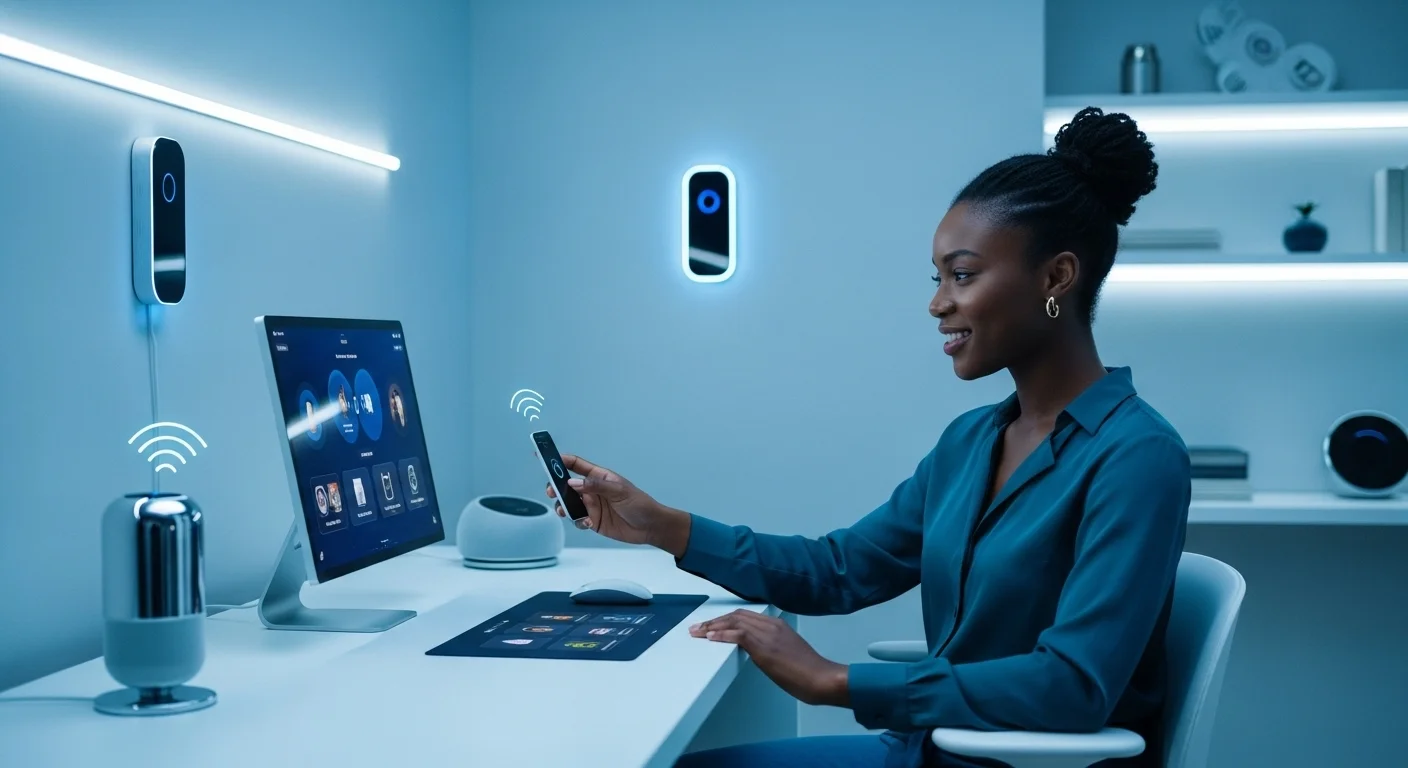Home Control Unlocked: Your Personal Guide to a Smarter 2025

Executive Summary
This is your personal guide to the world of home control, written from my years of experience as a smart home integrator. We'll break down the jargon and get straight to what matters: making your home or business smarter and more efficient. I'll show you how a simple smart device and a central hub work together to create magic. We'll explore the incredible power of open-source platforms, a topic I'm passionate about, which gives you ultimate control and privacy. We'll also dive into how this technology is changing businesses in hospitality, real estate, and even healthcare. From understanding the different communication 'languages' your devices speak to securing your system from threats, this guide is packed with real-world advice. Think of me as your trusted expert, helping you navigate everything from picking your first gadget to designing a complex, custom system.
Table of Contents
Table of Contents
- So, What Exactly is Home Control?
- The Core Components: Brains and Brawn
- The Tech Behind the Magic: How it All Connects
- The Power of Open Source in Home Control
- Beyond the Living Room: Home Control in Business
So, What Exactly is Home Control?
When I first got into this field over a decade ago, 'home control' meant a clunky universal remote that could barely manage a TV and a stereo. Today, it's a completely different universe. At its heart, home control (or home automation) is about teaching your home to think for you. It’s the technology that lets you manage nearly every electronic device—from your lights and thermostat to your security cameras and speakers—through a single, central system. The real magic isn't just about the convenience of turning off a light from your phone. It's about the profound impact on our energy use, our sense of security, and our ability to live more efficiently. In my experience, once you've lived in a home that anticipates your needs, it's hard to go back. For anyone in tech or business, understanding how these environments are built is no longer optional; it's fundamental to staying competitive.
The Core Components: Brains and Brawn
A truly smart environment, whether it's a home or an office, boils down to three key pieces. First, you have the 'brawn': the smart devices themselves. Think of a smart bulb like a Philips Hue, a thermostat like the Google Nest, or a smart lock on your front door. These are the individual soldiers on the ground, each with a specific job and the ability to communicate. The second, and most important, piece is the 'brains' of the operation: the home control hub. This hub is the central command center. It's what takes your request—whether spoken to a voice assistant or tapped on an app—and translates it into action for the individual devices. It's also where you build automated routines, like having your lights gently fade on in the morning. Hubs can be physical devices like an Amazon Echo Show or Google Nest Hub, or, for the more adventurous, powerful software running on a tiny computer in your closet. Finally, you have the user interface—the app on your phone or the voice assistant like Alexa or Siri—which is your personal remote control for your entire environment, accessible from anywhere in the world.
The Tech Behind the Magic: How it All Connects
To really get what makes this work, you have to look at the 'languages' these devices use to talk to each other. These are called communication protocols. While we all know Wi-Fi and Bluetooth, the smart home world has its own special dialects like Zigbee and Z-Wave. These are designed to use very little power, which is perfect for battery-operated sensors, and they create a 'mesh' network. In a mesh network, your powered devices, like smart plugs, act as little messengers, passing signals along to extend the network's reach and make it incredibly reliable. I've seen these networks cover large homes without a single hiccup. A huge development I'm excited about is a new standard called Matter. Backed by the big players like Apple, Google, and Amazon, Matter is designed to be a universal translator. The goal is that any device with the Matter logo will work with any hub that also supports Matter, ending the compatibility headaches we've dealt with for years.
But the real game-changer is the infusion of Artificial Intelligence (AI). AI is what elevates a system from just following commands to actually learning and adapting. I've set up systems where the thermostat learns a family's schedule and adjusts the temperature automatically, saving them money without them lifting a finger. AI-powered cameras can now tell the difference between a raccoon and a real intruder, which means you get alerts that actually matter. This intelligence is what turns a house full of gadgets into a genuinely smart, responsive home.
The Power of Open Source in Home Control
While the big tech companies offer polished, easy-to-use systems, there's a powerful movement that I'm personally a huge fan of: the open-source community. Platforms like Home Assistant or openHAB are a dream for anyone who values privacy, customization, and ultimate control. Unlike the big commercial systems that rely on the cloud, these usually run on a small, local server in your home (like a Raspberry Pi). This means two crucial things: your data stays with you, and your home keeps working even if your internet goes down. From a professional standpoint, the real beauty of home control open source is its limitless flexibility. I've used Home Assistant to connect brand-new smart lights with a 15-year-old security system for a client—something that would be impossible with a standard off-the-shelf hub. It empowers you to be the architect of your smart home, not just a customer.
Beyond the Living Room: Home Control in Business
This technology is so much more than a residential luxury. In the business world, the applications are transforming operations. I've consulted with offices that have slashed their energy bills by using smart lighting and climate control that adjusts automatically based on who is in the building. In hotels, smart room controls are becoming a new standard for a premium guest experience, allowing visitors to control their entire room with a tablet or voice command. The impact in healthcare and assisted living is even more profound. These systems can monitor the well-being of elderly residents by detecting falls or sending medication reminders, offering independence and peace of mind. Companies like home controls com, a distributor I've sourced from for years, have been pivotal in this growth since 1989. They supply the vast array of products, from a single smart device to complex systems, that professionals like me rely on to build these solutions for both DIY enthusiasts and large-scale commercial projects. The future is incredibly bright, and it's being built right now.

Your Complete Guide to Implementing Home Control
Putting together a home control system, whether it's for your family's convenience or your company's bottom line, is a journey. It requires understanding the tech, having a clear strategy, and knowing where to turn for help. Let's walk through the exact methods and resources I use when designing a system from the ground up, comparing the core technologies and exploring how to make them work for you.
Choosing a Language: Which Protocol is Right for You?
Think of communication protocols as the language your smart devices speak. Choosing the right one is the single most important technical decision you'll make. Here’s my real-world breakdown:
- Wi-Fi: It's everywhere and it's fast, which is great for things that need a lot of data, like your video doorbell. The downside? It's power-hungry, so it's a poor choice for battery-powered sensors. I've also seen home networks get bogged down when too many smart gadgets are trying to talk at once, slowing down laptops and phones.
- Zigbee: This is one of my go-to protocols. It’s a low-power mesh network, meaning your powered devices (like plugs and bulbs) act as signal repeaters, creating a super-reliable web of communication. It's an open standard, so there are tons of affordable devices out there. The only catch has been that some brands used to have their own 'dialect' of Zigbee, causing compatibility issues, but this is getting much better.
- Z-Wave: Very similar to Zigbee, but it operates on a different radio frequency that isn't as crowded as the one Wi-Fi uses. This means less interference. Because Z-Wave is a stricter, proprietary standard, every certified device is guaranteed to work with every other certified device. In my experience, this makes it incredibly reliable, though the devices can sometimes be a bit more expensive.
- Matter: This is the future, plain and simple. Matter isn't a new language itself; it's more like a universal translator that works over Wi-Fi and another low-power protocol called Thread. The promise is simple: if a smart device has the Matter logo, it will work with any Matter-certified home control hub, whether from Apple, Google, Amazon, or an open-source platform like Home Assistant. This will finally let us buy products based on features, not just brand compatibility.
Once you've considered the protocol, you need to choose your system's 'brain'—the home control hub. This is where you face the biggest fork in the road: a user-friendly commercial system or a powerful open-source platform.
Commercial Hubs (Amazon Alexa, Google Home, etc.): These are fantastic for getting started. The setup is usually a breeze, the apps are slick, and they work perfectly with their voice assistants. However, they almost always require an internet connection to work, and you're locked into what the manufacturer allows you to do. For many people, this is a perfectly fine trade-off for convenience.
Open-Source Hubs (Home Assistant, openHAB, etc.): This is where the real power lies, and it's the path I recommend for anyone serious about customization. Because they run on your own hardware in your home, they are more private and reliable. The community has built integrations for thousands of devices, letting you connect almost anything you can imagine. The learning curve is steeper, no doubt about it. But the reward is a system that does *exactly* what you want it to do, making home control open source the ultimate solution for tech enthusiasts and businesses with unique needs.
Business Strategy: Turning Smart Tech into Smart Business
For a business, a home control system is a strategic asset. Here's the playbook I follow with my commercial clients:
- Start with 'Why?': Before you buy a single gadget, define the problem. Are your energy bills too high? Is building security a constant headache? Once you know your goal, you can calculate the return on investment (ROI). For example, 'We will spend $5,000 on smart thermostats and lighting to save an estimated $3,000 per year on electricity.' This makes the project an investment, not an expense.
- Pilot Program First: Don't try to automate everything at once. I always recommend a phased approach. Pick one area—a conference room, a single hotel floor—and run a pilot test. This lets you work out the kinks, gather real data, and prove the concept's value before committing to a company-wide rollout.
- Embrace Open Source for Custom Needs: Businesses rarely have simple needs. I worked with a local brewery that used Home Assistant to monitor fermentation temperatures, track CO2 levels, and control their glycol chillers—all from one dashboard. This level of custom integration is simply impossible with consumer-grade products. Open source provides that flexibility.
- Create New Value: Smart technology can become a new revenue stream. Property managers can market 'smart apartments' as a premium feature. Assisted living homes can offer advanced monitoring packages. As an integrator, my business is built on designing these custom systems for clients, sourcing professional-grade gear from trusted distributors like home controls com.
Resources You Can Trust
Finding your way through the sea of products can be tough. For professionals and serious DIYers, distributors like home controls com are a lifeline. They offer a curated catalog of reliable products and provide the technical support needed to get the job done right. When comparing your options, here's where to look:
- Community Forums: For open-source platforms like Home Assistant, the community forums are the ultimate resource. They are a goldmine of tutorials, solutions, and shared wisdom.
- Manufacturer Specs: For commercial gear, always go straight to the source. The manufacturer's website will have the most accurate specs and compatibility lists.
- Independent Reviewers: Find a few YouTubers or tech sites that you trust. Their real-world testing can provide insights you won't find on a spec sheet.
Ultimately, a successful system comes from making informed choices. By matching the right tech to your specific goals and using quality resources, you can build a truly intelligent environment. The choice between a simple commercial system and a powerful open-source solution is yours, and with the industry moving toward standards like Matter, there's never been a better time to start.

Pro Tips for Mastering Your Home Control System
Getting a home control system up and running is just the beginning. The real art is in making it secure, efficient, and so intuitive that it fades into the background of your life or business. Over the years, I've developed a set of core strategies and best practices that I apply to every project. These are the tips that separate a frustrating collection of gadgets from a truly smart and reliable ecosystem.
My Golden Rules for a Secure and Reliable System
Connecting your home to the internet introduces risks, but they are entirely manageable. Security isn't an afterthought; it's step one. Here are my non-negotiables:
- Fortify Your Network: Your Wi-Fi router is the front door to your smart home. Lock it down. Use a strong WPA3 password, and please, change the default admin login credentials the moment you set it up. I strongly recommend creating a separate network (a 'VLAN' if you're technical) just for your smart devices. This quarantines them, so even if one device were compromised, the rest of your network—with your personal computers and phones—remains safe.
- Use Unique Passwords Everywhere: Every single smart device and app needs its own unique, complex password. Using the same password for everything is like leaving the master key under the doormat. A password manager is your best friend here. And wherever you see the option for two-factor authentication (2FA), enable it. It’s one of the best defenses you have.
- Update, Update, Update: Software and firmware updates aren't just for new features; they contain critical security patches. This is how manufacturers fix vulnerabilities after a product is released. Set your home control hub and devices to update automatically. For those that don't, I set a calendar reminder to check for updates once a month. It’s a simple habit that can save you from major headaches.
- Buy from Brands You Trust: Stick with reputable manufacturers who have a history of supporting their products with security updates. Those cheap, no-name devices from obscure online marketplaces can be a huge risk, as they might have poor security or be abandoned by their creators, leaving you vulnerable. Sourcing from a reliable distributor like home controls com helps ensure you're getting quality, supported hardware.
- Keep it Local When You Can: This is the number one reason I champion open-source solutions like Home Assistant. By processing your data and commands locally within your home, you dramatically reduce your exposure to the outside world. It also means your core automations will still work perfectly even if your internet service goes out.
Business Tools and Real-World Experiences
In a business context, a building automation system is a management powerhouse. The goal is to use data to drive intelligent action.
- The 'Single Pane of Glass' Dashboard: When managing multiple properties, like a chain of coffee shops, you need a central command center. I've used Home Assistant to build dashboards that show the energy use, security status, and temperature of a dozen locations on one screen. This gives a facilities manager incredible oversight without having to be everywhere at once.
- From Reactive to Predictive: Smart sensors can help you predict problems before they happen. Imagine a smart plug on a commercial refrigerator that monitors its energy use. If it starts drawing more power than usual, the system can flag it as a potential compressor failure and automatically alert the maintenance team. This simple smart device can prevent thousands of dollars in spoiled inventory.
- Connecting Your Business Systems: The real magic happens when your building talks to your other business software. I've set up systems where a client's meeting room booking calendar is linked to the room's automation. When a meeting is booked, the system automatically turns on the lights and sets the temperature 15 minutes beforehand. When the meeting ends, it shuts everything down. It's seamless, efficient, and saves money.
- Crafting a Better Customer Experience: Smart tech can be a huge differentiator. In a high-end salon, I helped design a system where clients could use a small tablet in their chair to adjust the lighting and select their own music playlist. It’s a small touch, but it elevates the entire experience and makes customers feel valued.
Your Guide to Continuous Learning
This technology changes fast, and staying informed is key. The most important development right now is the Matter standard, which is set to revolutionize how our devices work together. To get the most accurate, in-depth information, I always point my clients and fellow integrators to the source: the Connectivity Standards Alliance. Their official Matter page is an essential resource for anyone serious about future-proofing their smart system. You can find it here: Connectivity Standards Alliance - Matter. The site has the technical details, product lists, and white papers you need to stay ahead of the curve.
Ultimately, a successful strategy is built on a foundation of security, tailored to your unique needs, and designed to evolve. By combining smart security habits with the power of platforms like home control open source, and by using reliable hardware from trusted partners like home controls com, you can create a truly intelligent environment. It's a journey that starts with one smart device but leads to a fully automated ecosystem that delivers convenience, efficiency, and peace of mind.
Expert Reviews & Testimonials
Sarah Johnson, Business Owner ⭐⭐⭐
This was a good overview of Home Control, but as a business owner, I was hoping for more practical examples I could apply directly to my shop.
Mike Chen, IT Consultant ⭐⭐⭐⭐
A really solid article on Home Control. It cleared up a lot for me as an IT consultant, though a few of the technical concepts could have been broken down even more.
Emma Davis, Tech Expert ⭐⭐⭐⭐⭐
Fantastic article! It was incredibly thorough on Home Control and genuinely helped with my specialization. Everything was explained perfectly.



